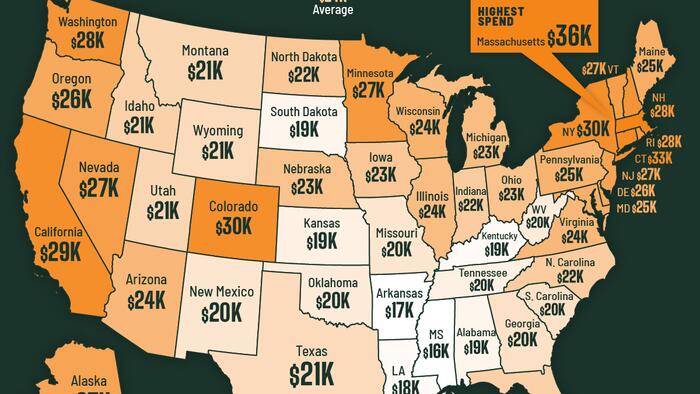Raising a child in the United States comes with significant financial implications, with average annual costs totaling around $23,000 for families with two working parents. This figure reflects a myriad of expenses that parents must navigate, including housing, food, childcare, healthcare, and transportation. Visual Capitalist’s graphic, based on data from SmartAsset, details the costs of raising a child in various states, revealing the substantial variances across the country. Furthermore, the methodology behind this research utilized the MIT Living Wage Calculator to gauge the financial landscape for households with one child compared to those without.
Among the states, Massachusetts leads with the highest annual cost of child-rearing, averaging $35,841, while Mississippi ranks lowest at $16,151. The infographic breaks down the annual costs per state, illustrating a wide disparity that highlights how geographical and economic factors impact family spending. Following Massachusetts, Hawaii and Connecticut also present high costs, while Southern states generally show lower expenditures, suggesting that economic conditions and local living costs significantly influence the financial burdens of raising a child.
The primary expense for families, regardless of their state, is childcare, which encompasses education, daycare, and babysitting costs. This category alone can strain family budgets, especially in states where the overall cost of living is elevated. In addition to childcare, housing emerges as another significant financial obligation. Housing costs incorporate rent or mortgage payments, property taxes, and utility expenses, all of which contribute to the growing financial commitments of parents. Furthermore, food expenses are substantial, reflecting not only general grocery shopping but also the rising prices of nutritional essentials.
Looking at the overall financial picture, it is essential to note that these expenses do not include the cost of college education, which can lead to even further fiscal pressure on families. The financial burden associated with raising a child can easily escalate over time, especially when considering long-term educational expenses. Without factoring in potential higher education costs, the figures merely paint a partial picture of the economic demands parents face throughout their children’s development.
Beyond the mere statistics, this analysis prompts discussions about the broader implications of financial upbringing in the U.S. Families may find themselves adjusting their lifestyles based on the financial constraints imposed by their locations, highlighting the interplay between regional economic health and family spending. Policymakers can draw insights from this data to better understand the economic pressures on families and potentially advocate for initiatives that support child-rearing costs, such as affordable childcare options or housing assistance programs.
For those intrigued by the comprehensive financial requirements of parenting and living arrangements in different states, further exploration into related infographics can illuminate additional facets of family economics. Insights from such analyses not only serve to inform parents about potential future costs but also position families to make educated financial decisions that foster stability and growth in the face of varied living expenses. Overall, the financial journey of raising a child is complex and multifaceted, demanding careful planning and consideration by parents across the United States.

